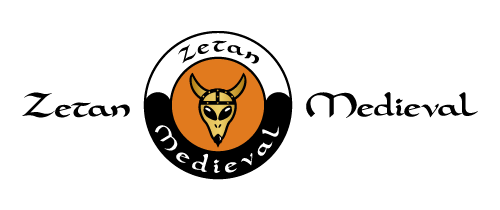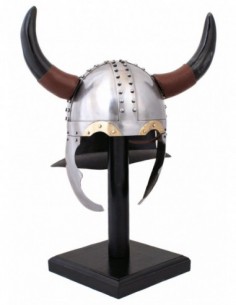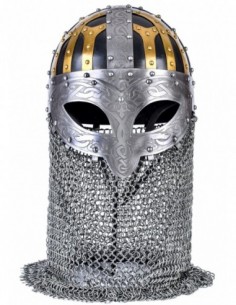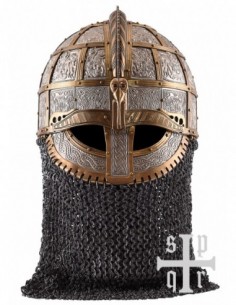Viking helmets
€87.98
Made from elaborately worked and riveted 1.6 mm steel. Delivery includes screws and holes in the helmet for assembly at home, as well as leather lining and chin strap.Made from elaborately worked and riveted 1.6 mm steel. Delivery includes screws and holes in the helmet for assembly at home, as well as leather lining and chin strap.
€123.09
Viking helmet of 2 mm steel, popular among the vikings of the VIII and IX centuries. Used with a coat of mail, it is strong, resistant and perfect for historical battles
€208.96
Viking helmet of century X with protection for the nose and coat of mail to protect the neck and the shoulders. It is lined in leather and has a leather strap for chin fastening, made of 2 mm steel
€252.96
Nordic medieval helmet made of 1.2 mm steel. Typical helmet of the time in the shape of half shell and with nose guard. Decorated with brass. Maximum head circumference: 63 cm.
€252.96
Nordic helmet of conical shape with plume of horse hair, made of steel 1.2 mm. And finished in bronze. Head circumference max. 64 cm. Wear leather straps inside for better fit to the head.
€164.98
2mm steel Viking helmet, leather inlay and chin strap, brass buckle - Suitable for head circumference up to approx. 59cm. And fully functional ready for battle.
€175.78
Late Roman spangenhelm made of 1.6mm steel. Functional helmet ready for battle. Head circumference TM 62 cm and TL 64 cm.
€197.98
Viking helmet for historical re-enactment, from the Vendel period with aventail chain mail, ready for battle. Material: steel approx. 1.6mm. Padded fabric entry and cowhide chin strap. Head circumference TM 62 cm and TL 64 cm.
€186.98
Fully battle-ready rebuild of a Viking Spangenhelm. This type of helmet was very popular among the northern fighters of the High Middle Ages, the Vikings, the Varangians, the Rus and the Normans. Material: 2mm steel. Nose thickness: approx. 4mm. Padded lining and cowhide chin strap. Head circumference TM, 61 cm and TL 64 cm.
€197.96
Viking Spangenhelm goggle helmet with armor and made of steel.
€208.98
The Gjermundbu helmet with riveted aventail, 2mm steel functional and ready for battle. Material: 2mm steel - Padded fabric lining and cowhide chin straps. Antique finish and weight approx. 2.9kg
€208.98
Viking Gjermundbu Helmet for Aventail Chainmail Goggles, 2mm Steel
€230.98
Viking Spectacled Helmet, 2mm Steel, with Plume and Aventail Chainmail
€307.98
Viking helmet type glasses with long nose guard, 2 mm steel.
€769.98
Spectacular Viking helmet that is manufactured and designed as a unique decorative piece of collection. It is not a functional helmet for battle.
€153.96
Spectical Beowulf helmet with cheek guards and aventail
€241.98
A helmet with angular cheek flaps, inspired by Viking Age helmets. The helmet has a comfortable adjustable leather inlay, a chin strap with a stylish matching buckle and an attached window made of burnished steel rings with an inner diameter of approx. 9mm. Weight approx. 2.2kg. Head diameter size M 61 cm, size L 65 cm.



































